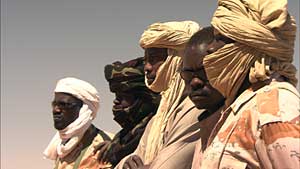 The population of Darfur is made up of over 80 different ethnic groups. Broadly speaking, the groups can be divided into Arab nomads and African farmers, though the people have always mixed and intermarried. The majority of both blacks and Arabs in the region are Muslim.
The population of Darfur is made up of over 80 different ethnic groups. Broadly speaking, the groups can be divided into Arab nomads and African farmers, though the people have always mixed and intermarried. The majority of both blacks and Arabs in the region are Muslim.
The current conflict in Darfur began in 2003, when black African rebel groups rose up against Sudan’s Arab-dominated central government, demanding an end to the social, economic and political marginalization of their region.
The government responded by arming the janjaweed, a mostly Arab militia, who began raiding and burning down entire villages, killing an estimated 70,000 people by September 2004, when the United States labeled the atrocities a genocide.
A small group of African Union peacekeepers arrived in Darfur in June 2004, and after a long struggle with the Sudanese government, United Nations troops were finally allowed into the region in December 2007.
To date, as many as 300,000 people have been killed and 2.5 million displaced in the conflict.
To learn more about the different forces and factions in Darfur, scroll down or click on the links below:
| Justice and Equality Movement (JEM) |
| JEM – Khalil Ibrahim
JEM was founded by African Muslims loyal to Islamist leader Hassan al-Turabi, whose National Islamic Front (NIF) backed President Omar al-Bashir’s 1989 coup. It is led by an intellectual, Khalil Ibrahim, who wrote The Black Book: Imbalance of Power and Wealth in the Sudan” — a book that focused on the concentration of Arab power in the region. JEM’s support comes mostly from the Zaghawa tribe. |
| JEM – Bahar Idriss Abu Garda
Bahar Idriss Abu Garda, a top official in Khalil Ibrahim’s JEM, split from the group and established his own faction in 2007. Abu Garda charged Khalil Ibrahim of adopting a totalitarian style of leadership, and described Ibrahim as “threat for the unity of Sudan” because he calls for the separation of Darfur. |
| The Government of Sudan |
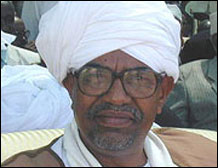 Rebels from Darfur were not the first to accuse the Arab-dominated government in Khartoum of marginalizing other ethnic groups. Similar complaints from black African Christians and animists in the south of Sudan sparked a civil war between north and south that has been waged almost continuously since 1962. Rebels from Darfur were not the first to accuse the Arab-dominated government in Khartoum of marginalizing other ethnic groups. Similar complaints from black African Christians and animists in the south of Sudan sparked a civil war between north and south that has been waged almost continuously since 1962.
In 2005, the government of Sudan signed a power-sharing agreement with rebels from the south in an attempt to bring an end to the decades-old civil war. The resulting Government of National Unity (GNU) is comprised of representatives from the National Congress Party (NCP) and the Sudanese People’s Liberation Movement (SPLM). The agreement stipulates that national elections be held in 2009. The Sudanese president, Omar al Bashir, came to power in an Islamist coup in 1989. Bashir was officially appointed president in 1993, and since then, has taken many steps to concentrate power into his own hands, included suspending both the parliament and the constitution at times. |
| The African Union and the United Nations:
When the crisis in Darfur erupted in 2003, the U.N. was focused on brokering a peace between the north and south of Sudan. A U.N. mission to Sudan, known as UNMIS, was established in 2004 with the goal of supporting the Comprehensive Peace Agreement between north and south. The burgeoning crisis in Darfur was not on the agenda. In July 2004, the U.N. passed its first resolution on Darfur, calling on the Sudanese government to end militia attacks in West Darfur and endorsing the deployment of African Union peacekeeping troops. A few days earlier, the U.S. House of Representatives had agreed to label the atrocities in Darfur a “genocide,” but the U.N. resolution refers only to “widespread human rights violations.” To date, the U.N. has yet to call the situation a genocide. Since the beginning of the crisis, the government of Sudan has opposed deeper U.N. involvement in Darfur, and has slowed the deployment of peacekeepers by refusing to allow non-African troops into the country. China — which buys 60 percent of Sudan’s oil and is the country’s main weapons provider — has used its position on the U.N. Security Council to help protect Sudan from sanctions. Despite these obstacles, after months of diplomatic wrangling, the joint U.N./African Union peacekeeping mission in Darfur was established by a unanimous vote in the Security Council in July 2007. |
| African Union |
| The Sudanese government and its allies were resolutely opposed to outside intervention in Darfur, but in 2004, they agreed to allow 465 African Union troops into the region to monitor a temporary ceasefire between rebel forces and government troops. This was the first peacekeeping mission for the African Union, an organization of 53 African nations. The African Union Mission in Sudan, known as AMIS, grew to a total of 7,000 peacekeepers by April 2005. But the small mission was underfunded and unable to provide adequate protection for civilians in Darfur. |
| United Nations/African Union Mission in Darfur (UNAMID) |
 On July 31, 2007, the U.N. Security Council authorized the establishment of the joint U.N./African Union Mission in Darfur (UNAMID), despite resistance from the Sudanese government. The joint mission officially took over for the African Union mission on January 1, 2008. On July 31, 2007, the U.N. Security Council authorized the establishment of the joint U.N./African Union Mission in Darfur (UNAMID), despite resistance from the Sudanese government. The joint mission officially took over for the African Union mission on January 1, 2008.
The force is led by Rodolphe Adada of the Republic of Congo and is commanded by General Martin Luther Agwai of Nigeria. At the insistence of the Sudanese government, all troops hail from African countries. Though the initial resolution establishing the force called for up to 26,000 troops, as of June 2008, only around 9,000 were deployed, including the 7,000 AMIS troops who were already in the region and came under UNAMID leadership. UNAMID is headquartered in El Fasher, the capital of North Darfur, and has a budget of $1.28 billion for its first year of operation. |
(SOURCES: CIA World Factbook, BBC, CNN, Sudan Tribune, UNAMID, AP, Human Rights Watch, The Sudan Human Security Baseline Assessment Project)

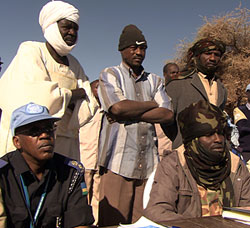
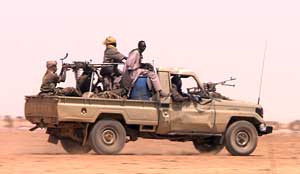 SLA-Unity
SLA-Unity
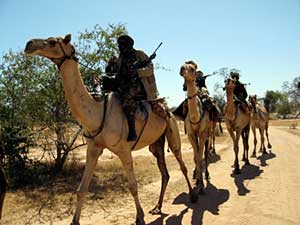 Darfur’s nomadic Arab herdsmen have long been in conflict with settled African farmers. But after black African rebels rose up against the Arab-dominated government in February 2003, local Arab militias, armed by the government, began raiding, looting and setting fire to villages inhabited by the black African Fur, Zaghawa, and Masalit tribes. These armed raiders usually arrive on horseback, and became known as the janjaweed, an amalgamation of the Arabic words for outlaw, horse and gun. The janjaweed are responsible for the worst atrocities in the Darfur crisis.
Darfur’s nomadic Arab herdsmen have long been in conflict with settled African farmers. But after black African rebels rose up against the Arab-dominated government in February 2003, local Arab militias, armed by the government, began raiding, looting and setting fire to villages inhabited by the black African Fur, Zaghawa, and Masalit tribes. These armed raiders usually arrive on horseback, and became known as the janjaweed, an amalgamation of the Arabic words for outlaw, horse and gun. The janjaweed are responsible for the worst atrocities in the Darfur crisis.